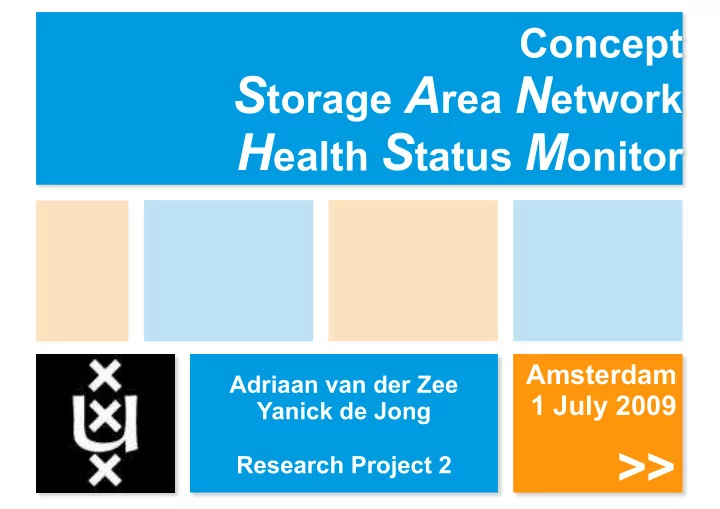

Concept S torage A rea N etwork H ealth S tatus M onitor Amsterdam Adriaan van der Zee 1 July 2009 Yanick de Jong >> Research Project 2 1
Content The organisation The project Storage infrastructure, physical and logical Problem conditions and indicators Health status levels Instant and historical status reports Conclusions Future work Questions 2
The organisation KLM IS delivers ICT-services to KLM’s business processes Electronic booking, online check-in, … Primarily database and web applications Different platforms (UNIX, Linux, Windows) are managed by their own departments A central Fibre Channel Storage Area Network (SAN) with connected storage systems is managed by the SAN department 3
The project Each department monitors its own systems to support their own daily operations Therefore the SAN department does not see storage related problems experienced by hosts A better understanding of the storage infrastructure’s health is desired 4
Problem definition How can an alarm system be created that monitors the long term as well as immediate health of a Fibre Channel fabric? What indicators are relevant for the health of the Fibre Channel fabric, and where can they be found? What are the important interrelations between such indicators, and how can they be quantified? What kind of health status levels can be defined, and by which indicators and thresholds should they be reached? 5
Storage infrastructure (physical) 6
Storage infrastructure (logical, 1) One or more hosts can share one or more HBAs , and each HBA can have one or more host ports connected to a switch port . Such a connection is a host link . One or more hosts share one or more LUNs . A fabric consists of one or more interconnected switches and includes all connected host ports and storage ports as well. A switch has one or more switch blades , which each contain one or more switch ports . An ISL is a link that connects a switch port to a switch port from another switch , both switches are by definition in the same fabric . A storage subsystem contains one or more LUNs which can be made available via one or more storage ports that are connected to a switch port . Such a connection is a storage link 7
Storage infrastructure (logical, 2) 8
Problem conditions Hardware failure Capacity shortage Reduced redundancy of load balanced components poses an extra risk Can be caused by hardware failure 9
Problem indicators DCB error Path failure Mirror out of sync Frame discard Over-utilisation Hardware failure Port latency 10
Relating problem indicators (1) An established problem can be related to other components A failed storage port on the fabric can be related to a number of affected hosts 11
Relating problem indicators (1) From some problem indicators, more specific relations can be found A DCB error points to a storage port A relation between DCB errors and frame discards on a storage port can be confirmed or denied 12
Health Status Levels (1) No problems Problems with no impact Limited impact Severe impact Per fabric, as well as in total 13
Health Status Levels (2) No No Limited Severe Fabric 1 problem impact impact impact Fabric 0 s No problems 1 2 4 8 No impact 2 4 8 16 Limited impact 4 8 16 32 Severe impact 8 16 32 64 14
Instant Health Status 15
Average Health Status 16
Conclusions A relational model of components relevant for the storage infrastructure has been developed Hardware failures, as well as (increased risks of) capacity shortages are indicators that affect the health status of the storage infrastructure Health status levels are determined by their impact, and the seperate fabric statuses are being combined Over longer time periods an average health status, and the amount of activity is presented 17
What's next? Implementation Evaluation Extra indicators and relations to enhance the system 18
Questions 19
Recommend
More recommend